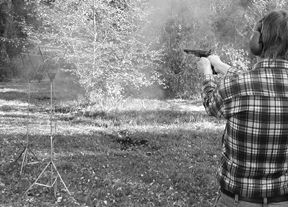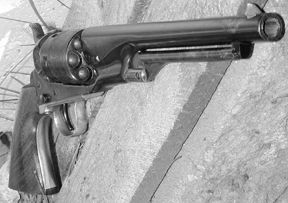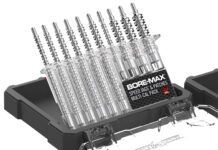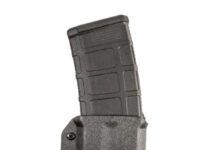
We have known about KIK black powder for a long time, but it was only recently we had a chance to test it. We chose to use GOEX powder as a comparison, though there are other brands out there, such as Elephant and Swiss. GOEX has given some of our staff the best results of those powders readily available, though we have not yet tried the Swiss brand.
We tested [PDFCAP(1)] over our Oehler 35P chronograph, using FFg-size powders. We didn’t test accuracy because that has not been significantly changed by changing powder types, in our experience. The firearms were a Colt 2nd Generation 1860 revolver and a Lyman .54-caliber flintlock rifle. We used the same priming powder in the flintlock with both GOEX and KIK, so it would not be seen as a variant. Ignition with our modified flintlock is near-instantaneous, beating some percussion-capped rifles we’ve seen over the years. We tried both 100-grain and 140-grain loads in the Lyman rifle. We used an adjustable powder-metering device, which gave the same volume of powder each time. The actual measured weight was very close to the volumetric number with both powders. The rifle was loaded with a Speer 0.530-inch lead ball seated in an Ox-Yoke 1000-Plus-lubricated patch. Five shots were fired with each powder type. We found no advantage of one powder over the other.
The Colt 1860 was loaded with approximately 33 grains of powder (actual weight), thrown from a tube affixed to a small flask. The chambers were then capped with an Ox-Yoke-lubricated Wonder Wad followed by a Speer 0.457-inch ball, rammed down very firmly. We did not cover the ball with grease as some advocate, because our extensive experience with Ox-Yoke’s Wonder Wads has shown that to be unnecessary. The revolver was then primed with No. 10 Remington percussion caps. We fired 12 shots with each powder over the chronograph screens. In the 1860, KIK showed a significant advantage. It outdid GOEX, 825 fps vs. 752 fps on average.

We also tried Hodgdon’s Triple Seven, a black-powder substitute supposed to be the equivalent of FFg black powder. In the flintlock, we found ignition to be very slow, with excessive hang times between pan flash and main-charge ignition. This was deemed untenable, and further tests with Triple Seven in the rifle were discontinued, despite promising higher velocities with the FFg-substitute Triple Seven. Subsequent shots with either GOEX or KIK again gave the expected near-instant ignition in the flintlock Lyman.
With the percussion ignition via Remington caps in the 1860 Colt, we had no hangfires and outstanding velocity with Triple Seven. We got 989 fps on average from the Hodgdon powder. This success pointed us in the direction of further testing to be done with black-powder cartridge firearms.
One final note was that we also tried some questionable KIK powder The powder had been stored in a common powder flask for several months instead of in a tightly capped can. This powder showed no advantage over fresh GOEX.
Gun Tests Recommends
In our tests, KIK produced better velocities than GOEX and had better reliability than Triple Seven.



























